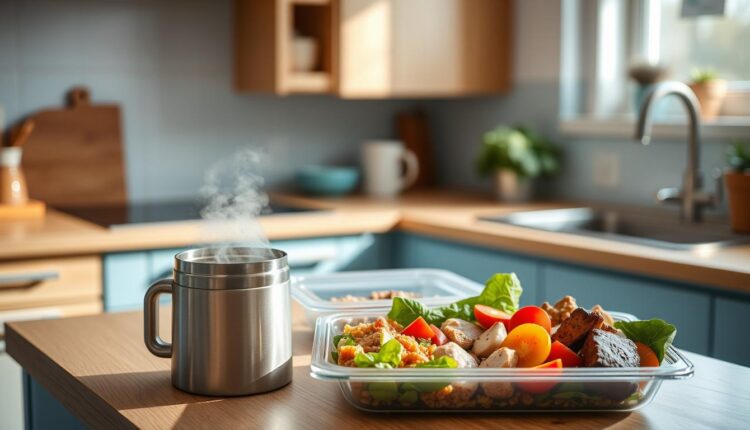Meal Prep For Work Late Shifts Energy Sustaining Options
Master meal prep for work late shifts with Chef Callie Renner’s expert tips. Prepare healthy, sustaining meals that fuel your demanding work schedule.
When I first started working irregular hours in Asheville’s restaurant scene, I quickly learned that surviving a 12-hour stretch requires more than caffeine. Your body needs real fuel – the kind that keeps your mind sharp at 3 AM without weighing you down. That’s where smart kitchen systems become your secret weapon.
Through years of testing (and occasional midnight snack fails), I’ve discovered simple ways to maintain energy during unconventional hours. This guide shares practical strategies from my own kitchen – like balancing proteins with slow-release carbs and timing your meals to match your rhythm. Whether you’re new to after-hours schedules or refining your routine, these approaches adapt to real-life constraints.
We’ll explore:
- Batch-cooking methods that actually survive Thursday’s fatigue
- Snack combinations preventing the 4 AM energy crash
- How a 12-hour night shift meal plan transforms your workday
No perfection required – just reliable nutrition that works when you need it most. Let’s build your sustainable energy blueprint.
the Unique Challenges of Night Shift Work
Working overnight in a 24-hour bakery taught me this: your body isn’t wired to digest chicken at 2 AM. Research shows night workers’ circadian rhythms lag 2-3 hours behind daylight schedules, creating a constant jet-lag effect. This mismatch impacts everything from blood sugar regulation to serotonin production.

When Your Internal Clock Works Against You
Your liver and pancreas follow sunlight cues, not your shift schedule. Eating during biological “nighttime” slows metabolism by up to 16% – like driving with the parking brake on. I’ve seen line cooks crash hard after carb-heavy midnight meals, only to stare at the clock during precious sleep hours.
Fighting the Grab-and-Go Trap
Irregular hours often lead to vending machine dinners or skipped meals entirely. A Johns Hopkins study found night workers consume 300+ more daily calories from processed snacks than day staff. The fix? Treat your lunchbox like a toolbelt – pack ingredients that repair (like magnesium-rich nuts) and sustain (think fiber-packed roasted veggies).
One ER nurse I coached said, “Planning my snacks like med doses changed everything.” By aligning her turkey roll-ups and chia pudding with her body’s least confused moments, she regained both energy and sleep quality.
Effective Meal Prep for Work Late Shifts: Strategies & Tips
Hospital kitchen consulting taught me a truth: successful fueling starts before your shift begins. When your schedule flips daily, pre-made components become lifelines. Here’s how to build flexibility into your routine without extra effort.
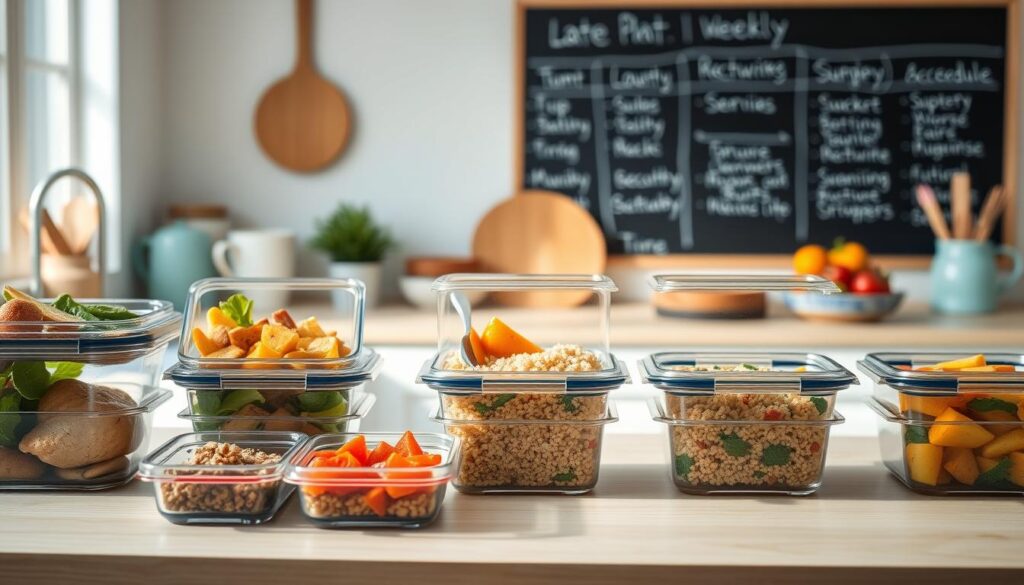
Planning Meals Around Irregular Hours
Adopt the “building blocks” method I use with ER staff. Roast three proteins (chicken thighs, tofu, shrimp) and two starches (quinoa, sweet potatoes) weekly. Store them separately – this lets you mix bowls in 90 seconds. A nurse I trained said, “Now I grab chili-lime shrimp with jicama slaw at 1 AM instead of gas station taquitos.”
Single-serve containers are game-changers. Portion hummus with veggie sticks during your Sunday reset. Freeze individual smoothie packs with spinach and peanut butter. These ready-to-grab items prevent decision fatigue when exhaustion hits.
Rotate flavor heroes like harissa paste or ginger-scallion oil to keep basics exciting. Last week, I turned leftover turkey into lettuce wraps (Asian-style) and tacos (chipotle-lime) using different sauces. This approach cuts boredom while maximizing ingredients.
Remember: your system should bend, not break. As one firefighter told me, “Some weeks I only prep hard-boiled eggs and overnight oats – and that’s enough.” Start small, stay adaptable, and let your energy needs guide you.
Planning and Preparing Nourishing Meals for Late Shifts
During my time coaching emergency room staff, I discovered a universal truth: organized kitchens fuel organized minds. Strategic preparation turns chaotic nights into manageable shifts. Let’s break down two pillars of sustainable energy – bulk cooking methods and ingredient intelligence.
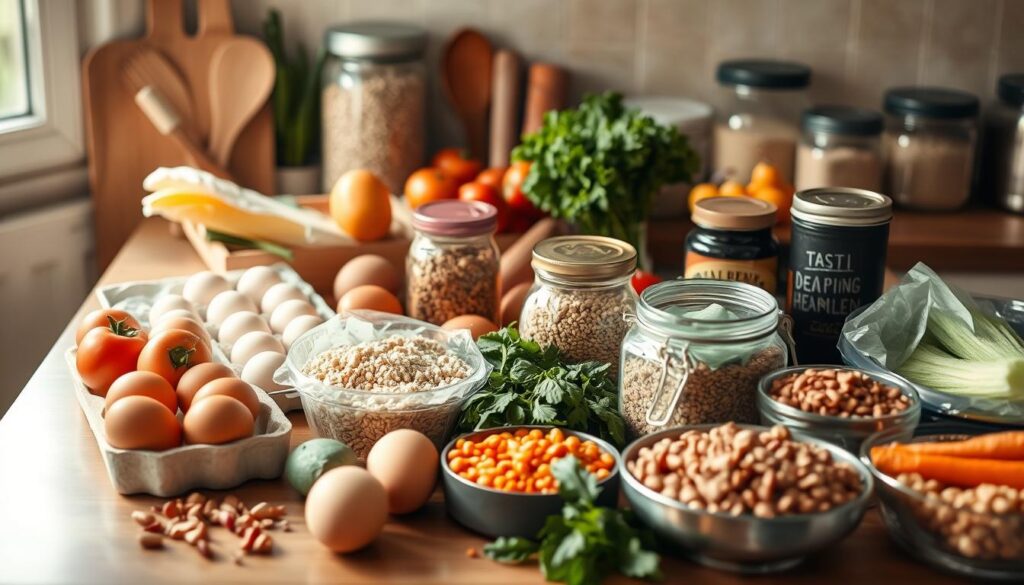
Batch Cooking and Bulk Prep Ideas
Think of your Sunday cook session as building a toolkit. Roast two sheet pans of chicken thighs (different spices on each) and a massive pot of brown rice. Steam three types of veggies – broccoli holds up better than spinach in containers. Store components separately using these guidelines:
| Component | Batch Amount | Storage Tip |
|---|---|---|
| Proteins (chicken, tofu) | 4-6 servings | Freeze in flat layers |
| Whole grains (brown rice) | 3 cups dry | Portion in muffin tins |
| Roasted vegetables | 2 baking sheets | Line containers with paper towels |
This system lets you mix bowls in minutes. Combine ginger-glazed chicken with snap peas Monday, then chipotle thighs with roasted peppers Wednesday. One firefighter told me, “I now eat better at 3 AM than most people do at noon.”
Selecting Whole Foods and Low GI Options
Low glycemic ingredients act like time-release energy capsules. Swap white rice for barley or farro – their chewy texture slows digestion. Pair roasted sweet potatoes (skin-on for fiber) with avocado for sustained fuel. My go-to combo? Garlicky kale massaged with lemon, quinoa, and shredded chicken.
Quality containers matter more than you’d think. Use glass jars for dressings-to-go and bento boxes with compartments to prevent sogginess. Label everything with dates – those Thursday night stuffed peppers will thank you later.
Rotate three base recipes weekly to avoid burnout. Try Asian lettuce wraps, Mediterranean grain bowls, and Southwest salads. Different flavors, same prep steps. As one night-shift nurse put it: “Variety keeps my lunchbox exciting, even when my eyes crave sleep.”
Smart Snacking and Hydration for Night Shift Energy
One midnight shift in a bustling ER kitchen showed me the power of strategic nibbling. A resident grabbed my homemade trail mix instead of the break room donuts and said, “This actually got me through the code blue.” That’s when I realized: after-hours energy depends on what you reach for, not just when.
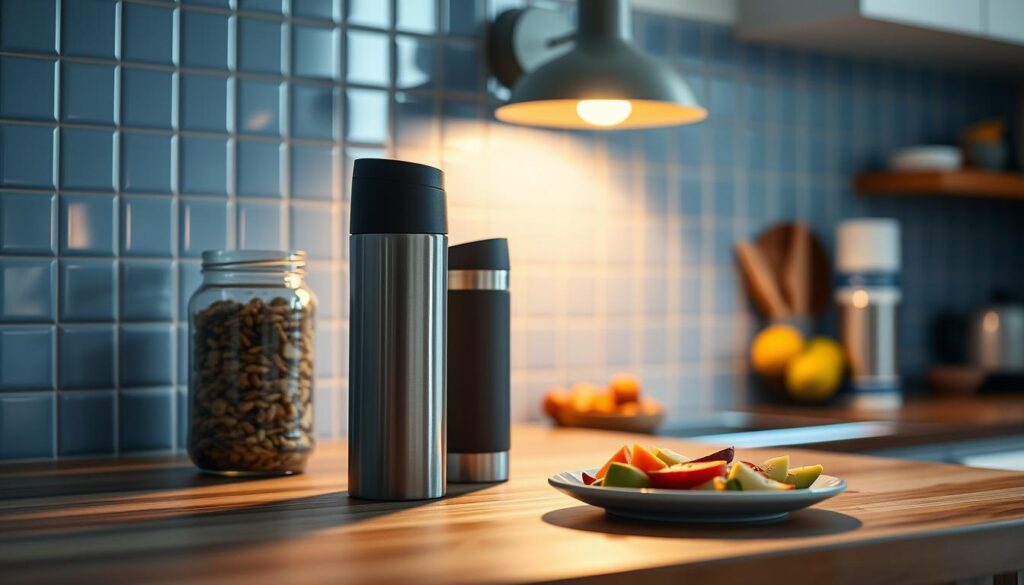
Healthy Snack Options to Maintain Alertness
Nutrient-dense bites act like mini energy boosters. Keep these combos in portion-controlled containers for grab-and-go moments:
- Almonds + dried cherries (magnesium meets antioxidants)
- Greek yogurt cups + frozen blueberries (protein + brain fuel)
- Hard-boiled eggs + cucumber slices (steady protein crunch)
A paramedic friend swears by her “alertness trio”: wasabi peas, dark chocolate-covered almonds, and crisp apple slices. The mix of heat, crunch, and sweetness keeps her engaged during long transports.
| Smart Choice | Why It Works | Portion Tip |
|---|---|---|
| Walnuts + pear | Omega-3s + natural sweetness | Pre-bag ¼ cup portions |
| Edamame pods | Plant protein + satisfying texture | Freeze single servings |
| Hummus + jicama | Fiber + creamy contrast | Use 2-oz dressing cups |
Hydration Tips for Sustained Energy
Dehydration mimics fatigue – a dangerous trap during critical hours. I carry a 24-oz bottle with lemon slices and mint. For every coffee, I drink two waters. Research shows proper hydration improves reaction times by 15% in night workers.
Herbal teas like ginger-turmeric or chamomile provide warmth without caffeine spikes. One night-shift nurse told me, “My peppermint tea ritual signals ‘focus time’ to my brain, even at 4 AM.”
Remember: sugary drinks create rollercoaster energy. Stick with infused waters, unsweetened kombucha, or electrolyte tablets in still water. Your third wind will thank you.
Implementing a 12-Hour Night Shift Meal Plan
While training ICU nurses in Charlotte, I noticed a pattern: those who ate like marathon runners – small, strategic fuel stops – outperformed others during critical moments. A well-timed nutrition strategy acts like an energy metronome, keeping your focus steady through the longest hours.
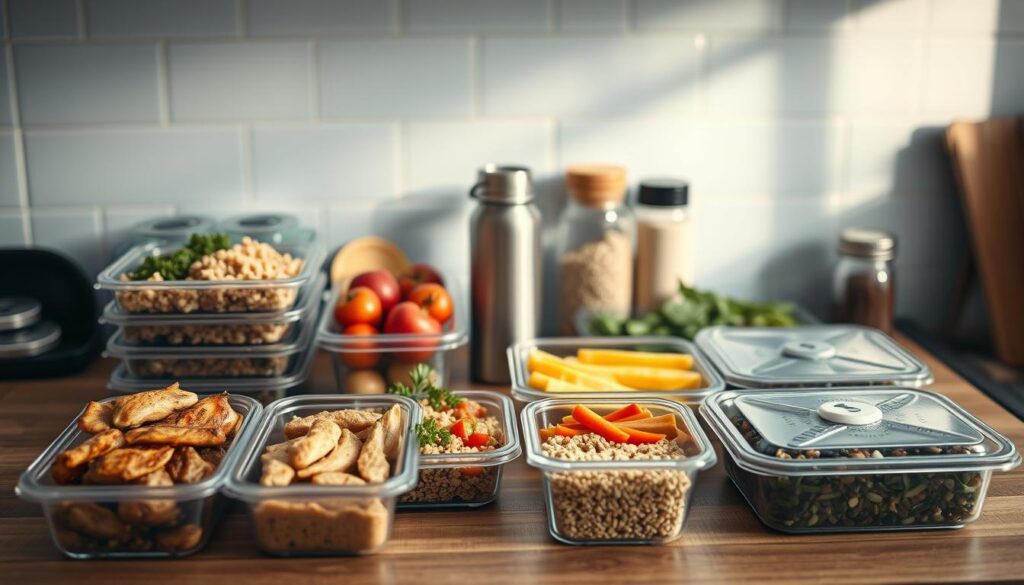
Meal Timing and Portion Control
Think of your shift as three acts, each needing specific fuel. Start with a protein-packed breakfast 90 minutes before work – say, Greek yogurt with chia seeds. Pack four snack-sized containers instead of three large meals. This prevents the 2 AM slump better than coffee ever could.
Try this tested schedule:
| Time | Food | Portion |
|---|---|---|
| 6 PM | Turkey-stuffed bell peppers | 1 cup filling |
| 9 PM | Almonds + apple slices | ¼ cup + ½ fruit |
| 12 AM | Grilled chicken salad | Palm-sized protein |
| 3 AM | Hard-boiled eggs + crackers | 2 eggs + 6 crackers |
Reheat proteins separately from grains to retain texture. A nurse told me, “Microwaving chicken over spinach instead of rice keeps it from getting mushy.” Smart move.
Incorporating Lean Proteins and Complex Carbohydrates
Rotate three proteins weekly: shredded chicken, marinated tofu, and flaky salmon. Pair with slow-burning carbs like farro or roasted squash. Last Tuesday’s dinner? Lemon-herb chicken thighs with barley pilaf – leftovers became next-day lettuce wraps.
Batch-cook grains in broth for extra flavor. Portion into ½-cup servings using muffin tins – they thaw faster than big clumps. For rushed mornings, blend oats with peanut butter and freeze in jars. Just add hot water at work.
Remember: Your body processes food differently at night. Keep fats moderate and fiber soluble (think avocado over broccoli). As one night-shift paramedic said, “Eating like it’s noon at midnight? That’s how you lose a whole hour to the bathroom.”
Coaching overnight paramedics revealed a universal truth: smart food choices transform grueling shifts into manageable hours. By focusing on balanced nutrition and intentional timing, you’ll sustain energy without sacrificing sleep quality.
Start with three core strategies: batch-cooked proteins for quick assembly, slow-burning carbs like farro, and hydration that goes beyond caffeine. Rotate flavor-packed ingredients to keep your lunchbox exciting – a dash of smoked paprika or lime zest can revive even the weariest 3 AM snack.
Remember, small tweaks create lasting change. Swap sugary options for roasted chickpeas. Portion nuts into single servings to avoid mindless munching. As one nurse shared, “Eating roasted peppers and hummus at midnight keeps my body fueled better than energy drinks ever did.”
Your night shift journey deserves quality fuel. Experiment with different recipes and timing until you find your rhythm. With these practical ideas, you’ll conquer the witching hours while protecting your health – one nourishing bite at a time.
Ginger Miso Quinoa & Veggie Power Bowls
A vibrant, nutrient-packed bowl featuring fluffy quinoa, crisp vegetables, and a zesty ginger miso dressing. Perfect for a wholesome lunch or dinner.
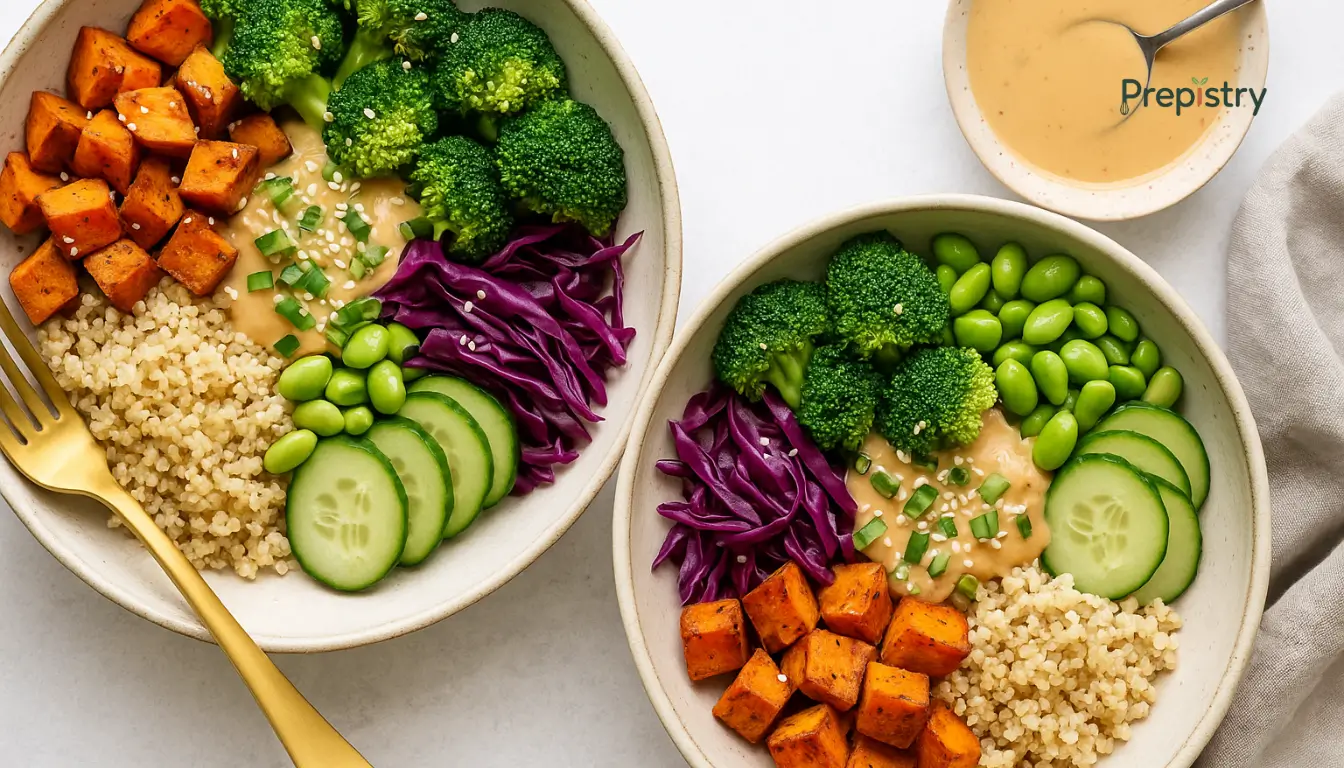
Nutrition Information
Equipment Needed
- Medium saucepan
- High-speed blender or food processor
- Mixing bowls
- Measuring cups and spoons
- Knife
- Cutting board
Ingredients
-
2 cups cooked quinoa
-
1 cup baby spinach
-
1/2 cup grated carrots
-
1/2 cup shelled edamame
-
1/4 cup dried cranberries
-
1/4 cup kimchi (optional)
-
2 tablespoons scallions, thinly sliced
-
2 tablespoons sesame seeds
-
2 tablespoons fresh ginger, grated
-
1 small garlic clove, minced
-
2 tablespoons white miso paste
-
2 tablespoons toasted sesame oil
-
3 tablespoons tahini
-
1 tablespoon honey or maple syrup
-
2 tablespoons lemon juice
-
1/2 cup water
Instructions
Recipe Video
Ginger Miso Quinoa & Veggie Power Bowls Recipe
Learn how to prepare a delicious and healthy Ginger Miso Quinoa & Veggie Power Bowl with this step-by-step tutorial.

